Last year, Black
Dog Kayaks offered to provide paddles
and skin-on-frame kayaks to John Dubina and Louis
Breckenridge as they paddled over two thousand miles
to raise money to research a cure for children's leukemia.
Working in partnership with the Livestrong Lance Armstrong
Foundation, and are planning on taking some of the
kids being treated at the Children's Hospitals along
for part of the journey.
We were excited at the opportunity to help and sent
a few designs to Louis and John, along with a number
of questions to determine what exactly they wanted
us to build for them. When we offered the kayaks to
them, we were imagining that we'd be building single
seat touring kayaks. To our surprise, they asked for
a tandem or, if possible, a triple kayak. Furthermore,
we were informed that they would not only be paddling
with a child in the kayak for part of the way, but
with a cameraman as well. Director Hiro Anan and his
film crew are documenting the journey from the planning
stages to the end of the River.
When asked if they wanted weight capacity or speed,
Louis informed us that they wanted speed, which led
us to the design that you see below:
The 19 Foot Tandem/Triple Kayak is based on our
single-seater Madeline 16, which we like for its sea-worthiness,
speed, and weight capacity. The prototype as designed,
featured two full size cockpits fore and aft, with
a smaller cockpit in the middle, suitable for a child
or for carrying extra cargo.
The deadline for the prototype was the end of August,
when we were supposed to meet in Cheyenne, Wyoming
to deliver the finished kayak to John and Louis so
that they can train on it this winter.
After finalizing the design, the first thing we did
was to cut out the pieces. After that, we spent most
of the week laying the pieces out on the ground, comparing
them with the plans as drawn, then either changing
the plans or changing the layout of the pieces, and
attaching them to the keelson, which is the backbone
of the kayak.
The curves all followed nicely and the length was
right at 19 feet, although we were going to lose at
least an inch due to the rocker that develops when
the sheer clamps are attached. If the middle looks
too wide open, that's because intermediate frame pieces
were added there later as needed.
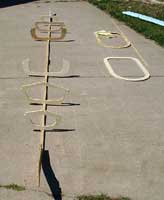 |
This is one
long skin-on-frame kayak
(click images
to enlarge) |
|
After the sheer clamps were attached, the next step
was to scarf the stringers, lay them into the proper
notches on the frames, and trim the angles on the
ends to fit at the stem and the stern.
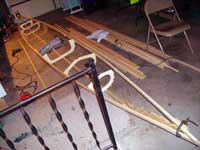 |
The sheer clamps
ready to be installed and trimmed |
| Here are all of
the stringers waiting to be scarfed |
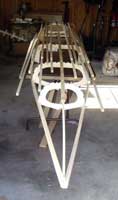
|
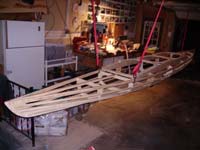 |
Hanging around,
waiting for paint |
Louis and John had requested a yellow kayak with
black trim, so it only seemed right that the frame
should be painted black. Black porch latex was used
because of its resistance to scuffing.
| I see a Kayak and
I want to paint it black |
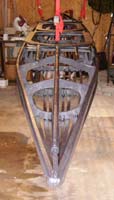
|
The kayak was skinned in two parts, top and bottom,
with yellow 18 ounce vinyl coated polyester. This
fabric is also used to make cargo tarps for semi-trailers.
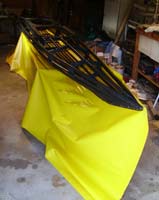 |
Right at the
deadline, the skinning was finished at 2 AM
the night before we had to leave for Cheyenne. |
The deck rigging was added after church the next
morning and the boat was loaded onto the roof of our
vehicle. The coamings were supposed to go on when
we got to Cheyenne, Wyoming, but they have yet to
be added.
| The blue kayak is
a Black Dog Kayaks Madeline 16. |
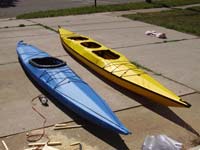
|
The prototype kayak is a Tandem/Triple, 19 ft long,
26 inches wide. Tandem/Triple means that the middle
cockpit is used for gear, but, if you need to, you
can put a 5 foot child in there.
When you build a prototype of a kayak, you'd like
to test it out and work out the bugs before you give
it to someone else to paddle. Of course, one of the
problems with building a prototype at the last minute
is that you don't get to do that. So, on the way out
west from my home in Michigan, we stopped at my sister’s
house in the Twin Cities. The next morning my brother-in-law,
Nick, and I got up bright and early and went to test
it out. Our initial reaction was that it handles nicely
with two guys. When Nick sat in it by himself and
paddled from the front cockpit, it sat fairly level,
but it wiggled a little in the back because of the
long length of kayak behind him. He also tried paddling
it from the small center cockpit and it paddled very
nicely, tracked well, and turned hard, just like you'd
expect a 19 foot kayak to do. After we took it around
the lake a couple of times, we concluded that, even
with a couple of two hundred pound guys paddling in
tandem, it's very stable, tracks well, and turns fairly
quickly for a tandem.
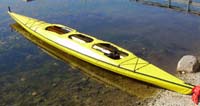 |
It floats in Minnesota!
The trim is black webbing and the deck cords
are 3/8 inch black bungee. All fasteners and
hardware are stainless steel. |
| My brother-in-law,
Nick, paddling from the front cockpit |
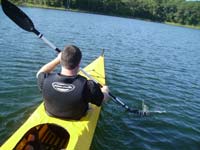
|
 |
Paddling solo
in a tandem |
| Besides the drain on gas mileage,
the kayak didn't cause any problems on the way
out to Cheyenne, Wyoming. The only glitch in the
trip was when my sister-in-law had car trouble
in Ogallala, Nebraska. |
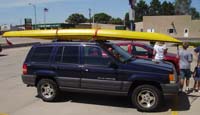
|
 |
I'm 6'10" tall, and
the kayak is 19 feet. |
| In the front yard
in Cheyenne, Wyoming |
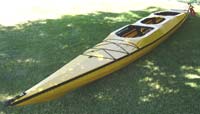
|
 |
Chris picked up the kayak
in Cheyenne and handed it off to Louis and John
in Colorado Springs for the trip home to Amarillo,
Texas. |
When we finally arrived in Wyoming, we passed the
Tandem/Triple Kayak on to our partners at Kayak 4
A Kure for training and for testing. Louis and John
planned on putting it through its paces on their way
home to see what they would like changed before we
build the kayaks that they'll be taking down the Mississippi
River next spring.
Postscript: True Confessions:
Yes, it looks great, and I did work my fingers to
the bone on it, but there was one problem... on the
way home after picking the kayak up, Louis and John
figured out a way to break it.
They were driving home to Amarillo, Texas, passing
through Pueblo, Colorado when Louis noted that the
Arkansas River passed through Pueblo. Why not test
it on the way home? They found the river and put the
boat in. At some point along the way, they turned
broadside in shallow water in a fast current, struck
a tree stump on the left side of the kayak, and five
stringers cracked...on the right side! John, in the
front seat, began to get a little worried. Louis hopped
out into knee deep water and pulled them to shore,
where they could assess the situation.
Below you'll find some pictures of the breakage. As
you can see, it was pretty substantial, but the kayak
did hold up, and got them home. They found that, while
the skin was still intact, the river current had broken
five stringers forward of the cockpit on the right
hand side.
| Here you can see
the damage to the prototype. |
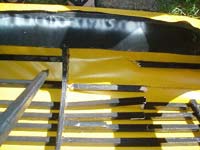
|
On consultation with us, it was determined that
there was a construction flaw, i.e., an error in judgment
on my part. When I built it, the cockpit rails, i.e.,
the frame pieces on which the cockpit frames and coamings
sit, should have been extended to the next frame forward
of the cockpit and tied in to that frame with some
glue and a couple of screws. They weren't, and it
turned into a problem when the water pressure went
up.
After that performance, we began to worry about whether
or not Kayak 4 A Kure wanted to continue with Black
Dog Kayaks. But, when I delivered the boat, I told
Louis that this was the very first one, and that it
was basically untested. That's the nature of the prototype.
You build the first one and you find out what works
and what doesn't. By the time the design becomes available
to the home builder, all the bugs are ironed out!
Some people have asked us what's taking so long introducing
more kayak models. Well, there you have it. We want
to make sure that you, the home builder, won't have
any surprises in the shop or out on the water.
Louis told me that they have paddled the kayak several
times since the accident. When I asked him how they
had repaired it, he replied, "We haven't repaired
it. We're just paddling it like it is!" They
were impressed that the kayak could suffer severe
frame damage and they could still paddle it! He commented
that other than the one problem, they love the kayak.
He also noted that it’s very stable and it tracks
very well. We both agreed that it would benefit from
a rudder, since, at 19 feet long, it takes a little
while to turn. In fact, the 19 foot length will be
lengthened to 21 feet, the frame will be strengthened
in the weak spot, and the center cockpit will be enlarged
to make it a true Triple Kayak. The additional length
should translate to a faster, even more stable kayak.
The current 19 foot design will probably find its
way into the Black Dog Kayaks stable as a Tandem.
At Black Dog Kayaks we were relieved to hear that
Louis and John are still committed to using our kayaks.
After we build another couple of test models, we'll
be sending Kayak 4 A Kure two or three kits, and the
River
Team will be building the boats that
they'll be using on the trip. The River Tem has now
grown to four paddlers and they feel that it will
increase team pride if they are able to build their
own kayaks.
When you finally build our Tandem/Triple and paddle
it, thank Louis and John at Kayak
4 A Kure for helping us come up with,
and perfect, a great design!
John and Louis will be paddling the Mississippi River
beginning in May 2007. To learn more about Kayak 4
A Kure, or, even better, to help support the effort,
please visit www.kayak4akure.com.
John and Louis are still in need of volunteers to
man the Chase Team. If you can help, please contact
them!
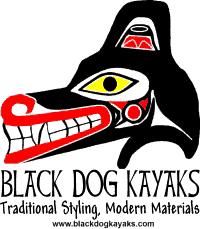

Other articles about skin-on-frame
kayaks:
|